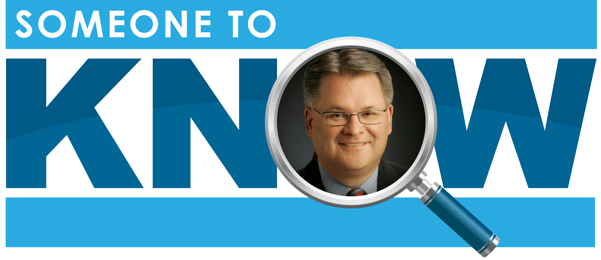Someone to Know: Q&A with Nationwide Chief Communications Officer (CCO) Rick Phillips
No one I know is more focused on best in class communications that deliver results than Rick Phillips. As Chief Communications Officer for Nationwide, Rick leads the company’s corporate communications program, serving all corporate, staff and business units within the company. He’s constantly motivating his team to think bigger, better and to ensure communications is positively impacting brand, reputation and performance. Rick offers terrific advice on a wide range of topics communicators care about, including the art of providing leaders sound and courageous advice, even when it may not be what they want to hear.

Q&A with Rick Phillips,
Chief Communications Officer (CCO)
at Nationwide
Q: How do you see your role as Chief Communications Officer for Nationwide?
A: I tend to think of my role as a “dot connector.” Nationwide is a complex company with multiple businesses. We serve our customers (known as members) with more than 30,000 employees (that we call associates). As a complicated organization, our associates are bombarded with many different messages from local managers, business leaders, and corporate executives. While each of these are important and necessary, our associates could potentially see them as random or unconnected. Our goal is to help them understand that every one of these dots somehow connect. Externally, our goal is to show the breadth and depth of the organization in a way that shows the entirety of Nationwide as a unique Fortune 100 company. People historically have known us as a home and auto company, because until recently, that’s what we’ve advertised. Until a few years ago, we had 15 different brands consisting of things from Pet insurance, specialty insurance, mutual funds, retirement plans, a bank, and many, many more. Now they are under one umbrella. Our goal is to tell the unified Nationwide story to both external and internal audiences so that everyone knows who we are and what solutions we can bring to bear to serve them. As I said, I simply think about that as connecting many differing dots.
Q: What are the biggest trends in corporate communications today that you think will stick?
A: Probably the most important trend is employee as ambassador. Research has shown that people tend to believe “people like themselves” to a much greater extent than traditional authority figures. This is particularly true if employees are engaged. Nationwide does a great job cultivating associate engagement and subsequently enjoys world-class engagement, as measured by Gallup. We’re just starting to explore how to create true ambassadors out of our associates but I’m convinced this is the future for all brands. The associate remains the most important audience we have and if leveraged correctly, can be the most credible advocate for the business.
Another isn’t a trend but rather a recognition by leaders that true communication is actually two-way. When I entered the field, we were often asked for a one-way push. The belief was, in effect, you could fill a syringe with communication and simply give your audience a shot of information and understanding would be complete. Today, they’re beginning to realize it’s two-way, and due to social media, this conversation is expected by the audiences we serve. This is true, by the way, internally as well as externally.
Q: What tried and true strategies do you count on to help leaders understand the value of communications?
A: Metrics are important. Did the intended audience understand the point of the communication? Did their behavior change? Are they taking that information and putting it into their own words? Is associate engagement going up? These are things we try to learn from our work and share with our leaders. Like many other companies, we prepare a quarterly communications scorecard. In it, we track things such as associate touch points (town halls, message themes, intranet stories, etc.) and external metrics, such as story placements, sentiment, favorability, issues managed and overall percent of stories tied to public relations programming. But we’re always interested in finding new ways to show real value, which means tracking outcomes rather than activity, and showing how we’re moving the needle in associate understanding.
Ironically, leaders sometimes gain a better understanding of the value of our work when they don’t take our counsel. In those cases, if the communication failed to connect with an audience but we were on the record with different counsel, we typically enjoy increased trust. And many times, that makes the next opportunity to provide counsel more credible. For this reason, I always ask the team to provide communications input and counsel, regardless of the issue or situation. We understand that part of our job is to ensure leaders are aware of potential risks – and opportunities – within any situation.
Q: What advice do you have for organizations looking to build their brand?
A: Focus on reputation and issues management. Advertising can build generic awareness and sell products, and it does these things incredibly well. But nothing compares to a reputational crisis for seeing how customers and potential customers perceive your brand. Over the past several years, we’ve seen companies – both large and small – wrestle with important questions about affiliations with controversial brands, their own business practices, customer service, leader misconduct, and other reputational issues. How brands respond in these moments of truth is a litmus test for public perception. Also, while obvious on many levels, some organizations don’t realize that there is no such thing as an internal message. In some cases, for example, we’ve had reporters reading our internal messaging back to us in minutes while subsequently asking for a comment. The best companies tell their stories “inside out,” making sure that their associates know, understand, and can communicate the information before they read it in a newspaper, blog, social site or some other form of media.
Q: We get asked often to share what the best companies are doing when it comes to communicating. Your communications team rocks. In what ways would you say they demonstrate world-class communications?
A: Thank you. I’m very proud of my team for the work they do. The simple answer is that the team is successful because they listen for understanding, anticipate needs, predict what may occur in an “if, then” mode, and see the biggest possible picture. But it’s critical to nail the tactics as well as the strategy. There is no magic to that part of the equation. Rather, it’s paying attention to the “nitty gritty” detail work.
We talk a great deal about seeing the big picture. For example, I ask my external/PR team to bring internal ideas to the table, and I want my internal communicators to do the same with external issues. In my experience, no one has asked for half a solution (just internal or external) and any nuances are so interconnected that it’s critical for every team member to see the entire picture. This allows us to make suggestions or decisions that provide the most value.
I also believe that a world-class team must be courageous as they counsel leaders. Satisfying a leader is important, but it’s a secondary consideration for a good communicator. If we are truly providing what they need and not just what they want, I expect to have some disagreement from time to time from team members as well as leaders. When things run too smoothly, I get suspicious about whether we’re providing real value by providing true counsel, versus simply making a leader happy. This is a skillset we focus on regularly.
Another consideration for leader communication is to leverage the strengths of the individual leader. We understand that we must mix up distribution methods, but we also know that some leaders are good in town halls, others are good on video, some prefer the written word, and so forth. In one case, due to leader movement, one of my communicators supported three very different leaders in the same position. In the span of about 18 months, she essentially had three different jobs without changing her role. Why? Every leader needed a customized plan and each had different skills than the last.
Q: I know you place great importance on your team’s development and ability to demonstrate value to the business. What advice do you have for other leaders looking to build their team and drive more value?
A: We’re never satisfied. We know that someone is probably doing this work better and so discovering best practices is key. We also spend a great deal of time learning what career path each team member is on, and what needs to happen to help them achieve their goals. We encourage professional organization membership, such as IABC and PRSA, and seek out communication training from other reputable experts in the communications and PR fields. In addition to learning new things, there’s also a side benefit. Often, we discover that when we see what others are doing, either in our industry or in the communications industry in general, we may be doing it as well or better than anyone and it becomes a genuine point of pride for our team.
But perhaps the best way to show value is a deep understanding of our business, both locally with the leader they support as well as having an enterprise-wide perspective. Our best communicators can not only talk about the business of their leader, but also about how that piece of business ladders up within the enterprise. There is no better way to drive communications value than by applying a keen understanding of business knowledge.
Q: It’s been said that curiosity is one of the most important traits of a great leader. How has simply being curious helped you to be a better leader? How has it led to better decision making for your organization?
A: A popular truism is that people are like businesses; either they’re growing or they’re dying. I believe in this notion and know that curiosity is key to being a good communicator. Although I’ve been doing this work for nearly four decades, I’ve never tired of learning or trying to figure out what makes human beings tick. It’s fascinating. That also includes figuring out how to use new technologies, staying up to speed on issues, events, and trends, and simply looking for ways to connect with individuals either one-on-one or in group settings. Communicators are fortunate because we live in a virtual petri dish that’s full of concepts, ideas, and solutions, but sometimes we must look to see them in a different way or turn a concept on its head to help bring understanding to others. Curiosity allows us to see what others might miss.
----

Rick Phillips is Chief Communications Officer (CCO) for Nationwide, leading Nationwide’s corporate communications programming and serving all corporate, staff and business units within the company. He has responsibility for c-suite communications, media relations and issues management, internal communications, editorial functions of the intranet, executive positioning and company brand communications. Nationwide, a Fortune 100 company, employs more than 33,000 associates throughout the United States. For more on Rick and his work click here.
To read more executive Q&As in our Someone to Know Series, click here.
Click below to download the eBook—Going Slow to Go Fast: Making Internal Communication Work For You—and learn how to navigate the core challenges that today’s communicators face: technology, culture changes, company leadership, and more!

Comments on this post